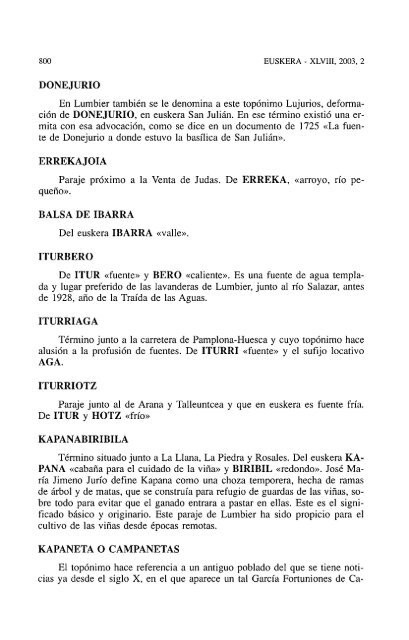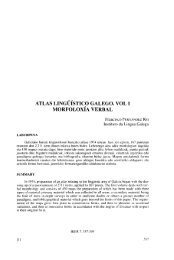toponimia y léxico vascos de lumbier/irunberri - Euskaltzaindia
toponimia y léxico vascos de lumbier/irunberri - Euskaltzaindia
toponimia y léxico vascos de lumbier/irunberri - Euskaltzaindia
You also want an ePaper? Increase the reach of your titles
YUMPU automatically turns print PDFs into web optimized ePapers that Google loves.
800<br />
DONEJURIO<br />
EUSKERA - XLVIII, 2003, 2<br />
En Lumbier también se le <strong>de</strong>nomina a este topónimo Lujurios, <strong>de</strong>formación<br />
<strong>de</strong> DONEJURIO, en euskera San Julián. En ese término existió una ermita<br />
con esa advocación, como se dice en un documento <strong>de</strong> 1725 «La fuente<br />
<strong>de</strong> Donejurio a don<strong>de</strong> estuvo la basílica <strong>de</strong> San Julián».<br />
ERREKAJOIA<br />
Paraje próximo a la Venta <strong>de</strong> Judas. De ERREKA, «arroyo, río pequeño».<br />
BALSA DE IBARRA<br />
Del euskera IBARRA «valle».<br />
ITURBERO<br />
De ITUR «fuente» y BERO «caliente». Es una fuente <strong>de</strong> agua templada<br />
y lugar preferido <strong>de</strong> las lavan<strong>de</strong>ras <strong>de</strong> Lumbier, junto al río Salazar, antes<br />
<strong>de</strong> 1928, año <strong>de</strong> la Traída <strong>de</strong> las Aguas.<br />
ITURRIAGA<br />
Término junto a la carretera <strong>de</strong> Pamplona-Huesca y cuyo topónimo hace<br />
alusión a la profusión <strong>de</strong> fuentes. De ITURRI «fuente» y el sufijo locativo<br />
AGA.<br />
ITURRIOTZ<br />
Paraje junto al <strong>de</strong> Arana y Talleuntcea y que en euskera es fuente fría.<br />
De ITUR y HOTZ «frío»<br />
KAPANABIRIBILA<br />
Término situado junto a La Llana, La Piedra y Rosales. Del euskera KA·<br />
PANA «cabaña para el cuidado <strong>de</strong> la viña» y BIRIBIL «redondo». José María<br />
Jimeno Jurío <strong>de</strong>fine Kapana como una choza temporera, hecha <strong>de</strong> ramas<br />
<strong>de</strong> árbol y <strong>de</strong> matas, que se construía para refugio <strong>de</strong> guardas <strong>de</strong> las viñas, sobre<br />
todo para evitar que el ganado entrara a pastar en ellas. Este es el significado<br />
básico y originario. Este paraje <strong>de</strong> Lumbier ha sido propicio para el<br />
cultivo <strong>de</strong> las viñas <strong>de</strong>s<strong>de</strong> épocas remotas.<br />
KAPANETA O CAMPANETAS<br />
El topónimo hace referencia a un antiguo poblado <strong>de</strong>l que se tiene noticias<br />
ya <strong>de</strong>s<strong>de</strong> el siglo X, en el que aparece un tal García Fortuniones <strong>de</strong> Ca-





